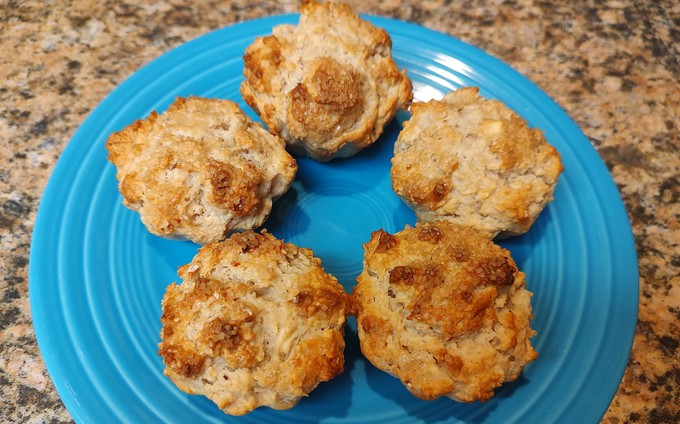
Recipe: Fresh apple muffins with vanilla yogurt

Great for breakfast on the run, fresh apple muffins are packed with chopped apples. Debbie Arrington
Fall is apple season. For many households, it’s also the busiest time of the year with so many activities (and deadlines).
These apple-packed muffins make a quick breakfast treat or portable midday snack. They’re finely textured and don’t fall apart (good for when on the go). The key is finely chopping (or shredding) the fresh apple. Big chunks can create holes in the baked muffin.
It takes about two large apples for 1-1/2 cups of chopped or shredded. Choose a juicy variety such as a Red Delicious or Gala. The sweeter the apples, the sweeter the muffins.
Fresh apple muffins
Makes 12
2 cups all-purpose flour
½ cup sugar
1-1/2 tablespoons baking powder
½ teaspoon salt
½ teaspoon ground cinnamon
½ teaspoon ground nutmeg
¾ cup vanilla or plain yogurt
¼ cup low-fat milk or apple juice
1 egg, lightly beaten
4 tablespoons (½ stick) butter, melted and cooled
1-1/2 cups apple, cored, peeled and finely chopped
2 tablespoons sugar
Preheat oven to 375 degrees F. Prepare muffin tin; grease or line cups. Set aside.
In a large bowl, sift together flour, sugar, baking powder, salt, cinnamon and nutmeg.
In a small bowl, mix together yogurt, milk or juice and egg. Fold in melted butter.
Make a well in the dry ingredients and pour in wet ingredients. Mix gently until batter is just blended. Fold in chopped apple.
Fill cups of prepared muffin tin about two-thirds full. Sprinkle sugar on top of batter.
Bake at 375 degrees for 30 minutes or until tops are golden and a wooden toothpick inserted near the middle comes out clean. Remove from oven and let cool in tin for 5 minutes, then remove.
Serve warm or at room temperature.
Comments
0 comments have been posted.Sacramento Digs Gardening to your inbox.
Sites We Like
Garden Checklist for week of July 21
Your garden needs you!
* Keep your vegetable garden watered, mulched and weeded. Water before 8 a.m. to reduce the chance of fungal infection and to conserve moisture.
* Feed vegetable plants bone meal, rock phosphate or other fertilizers high in phosphate to stimulate more blooms and fruiting. (But wait until daily high temperatures drop out of the 100s.)
* Don’t let tomatoes wilt or dry out completely. Give tomatoes a deep watering two to three times a week.
* Harvest vegetables promptly to encourage plants to produce more. Squash especially tends to grow rapidly in hot weather. Keep an eye on zucchini.
* Pinch back chrysanthemums for bushy plants and more flowers in September.
* Remove spent flowers from roses, daylilies and other bloomers as they finish flowering.
* Pinch off blooms from basil so the plant will grow more leaves.
* Cut back lavender after flowering to promote a second bloom.
* It's not too late to add a splash of color. Plant petunias, snapdragons, zinnias and marigolds.
* From seed, plant corn, pumpkins, radishes, winter squash and sunflowers.